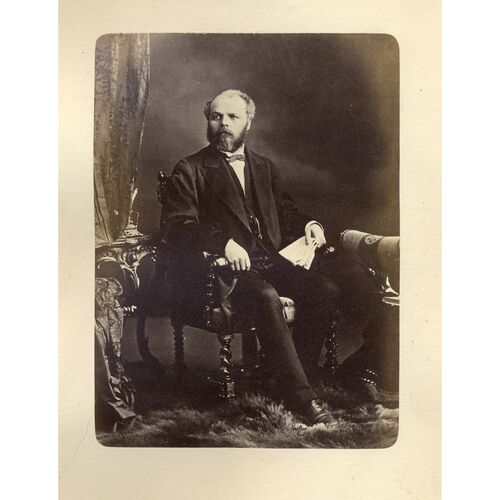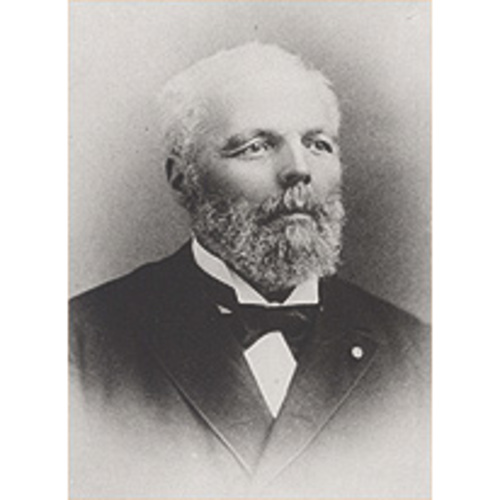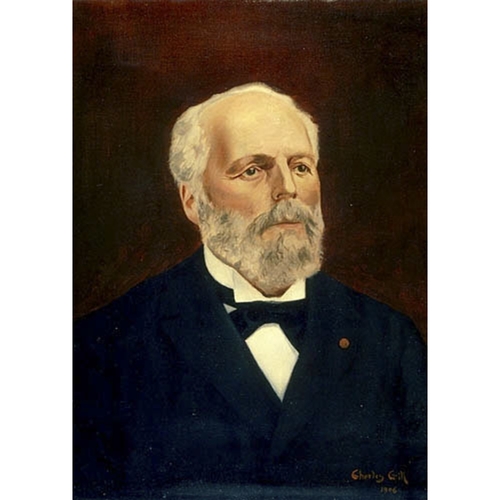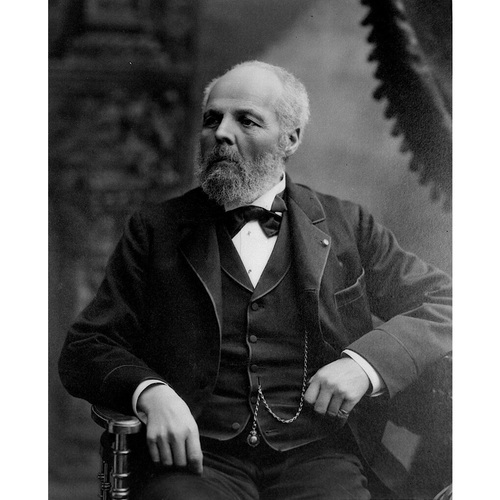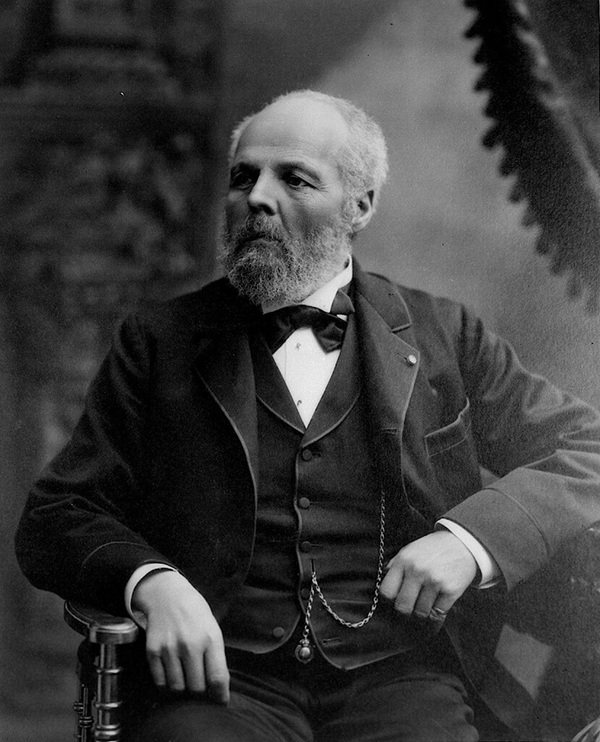
Source: Courtesy of Wikimedia Commons
OUIMET, GÉDÉON, lawyer, politician, and office holder; b. 2 June 1823 in Sainte-Rose (Laval), Lower Canada, son of Jean Ouimet, a farmer, and Marie Bautron; m. 13 Aug. 1850, in Montreal, Marie-Jeanne Pellant, daughter of the late Alexis Pellant, a farmer, and Élisabeth Lionnais, and they had four sons and three daughters who reached adulthood; d. 23 April 1905 in Saint-Hilaire (Mont-Saint-Hilaire), Que., and was buried 26 April in Notre-Dame-des-Neiges cemetery, Montreal.
Gédéon Ouimet was his father’s 26th child, and, according to Auguste Achintre*, when he was born, “following an ancient custom, [he] was carried triumphantly to the presbytery and offered as a tithe to the respectable curé of the parish,” in the same way that the 26th minot of wheat was given in those days. The priest died before he could provide for the child’s education, however. In 1834 Gédéon’s parents sent him to the Séminaire de Saint-Hyacinthe, where, despite a good beginning, he was a mediocre student. This school record may explain why he was enrolled in the Petit Séminaire de Montréal in 1837. Two years later he began articling as a law student with the firm of his brother André*, the former president of the political wing of the Fils de la Liberté. On 26 Aug. 1844 he was called to the bar in Montreal.
While articling, Ouimet had been in contact with clients from the countryside who came to his brother’s office. He opened a practice in Saint-Michel-de-Vaudreuil, a parish encompassing the seigneury of Vaudreuil. The parish was erected into a municipality in 1845, and then into a village on 12 April 1850. Ouimet served as its mayor from 1852 to 1854. When his term came to an end, lie moved to Montreal, where he went into partnership with Louis-Siméon Morin* and Louis-François-Wilfrid Marchand under the name of Ouimet, Morin et Marchand. A member of the council and board of examiners of the Montreal bar, he contributed articles to the Lower Canada Jurist, which contained decisions handed down by the various civil courts of Lower Canada and was published by John Lovell* from 1857. At the time of the union of Upper and Lower Canada, Ouimet, like his brother, had supported Louis-Hippolyte La Fontaine* and Robert Baldwin*. Now, with Morin, he was an active member of the Liberal-Conservative party. In the general election of 1857–58, when the coalition formed in 1854 faced its first test of popularity, Morin was returned by acclamation in Terrebonne, and Ouimet in January 1858 defeated Charles Daoust*, the editor of Le Pays, in Beauharnois. Daoust had alarmed the Catholic clergy by endorsing Joseph Papin*’s defence of non-denominational schools, and they had thrown their weight behind Ouimet. The results of the election revealed the political division between the two sections of the colony: the Bleus in Lower Canada and the Reformers in Upper Canada had both consolidated their positions. In the Legislative Assembly the government of John A. Macdonald* and George-Étienne Cartier* enjoyed a majority of about 30 votes but was supported by only a minority of members from Upper Canada, as was demonstrated by the political crisis that brought the short-lived cabinet of George Brown* and Antoine-Aimé Dorion* to office in August. The imbalance provoked partisan quarrels and exacerbated the Reformers, who were demanding representation by population. Ouimet made his parliamentary debut in this highly charged atmosphere. He proved to be a back-bencher who was attentive to his constituents, hard-working, loyal to his leaders, and capable of making appropriate speeches at difficult times. In the election held in the summer of 1861, Macdonald and Cartier retained the support of the voters, although the Bleus lost a dozen ridings in Lower Canada, including Beauharnois, where Ouimet went down to defeat.
While remaining active in the Liberal-Conservative party, Ouimet devoted himself to the practice of law, which he had not in fact abandoned. Young Joseph-Adolphe Chapleau* had just finished articling at Ouimet et Morin. Ouimet periodically reorganized his firm as circumstances required: it was Moreau, Ouimet et Chapleau from 1862 to 1866, Moreau et Ouimet from 1866 to 1871, Moreau, Ouimet et Saint-Pierre from 1872 to 1874, and Moreau, Ouimet et Lacoste from 1875 to 1876. Throughout these years Ouimet’s prestige was growing both in judicial circles and in his party.
The confederation of Canada in 1867 marked a turning-point in Ouimet’s career. On 15 July Pierre-Joseph-Olivier Chauveau*, whom Cartier and Hector-Louis Langevin had propelled into office as premier of Quebec in place of Joseph-Édouard Cauchon*, made Ouimet attorney general, although Cartier urged the appointment of his own partner, François-Pierre Pominville, instead. Then 44 years old, he was well off financially, highly regarded within the legal profession in Montreal, and respected by the Montreal Conservatives, so that Cauchon also had considered giving him the portfolio. In his Manuel électoral, Achintre described Ouimet as “having an open and kind face, manly . . . features, a broad forehead, [and] intelligent eyes,” and expressing moderate “but substantial” opinions in a “naturally deep” voice with “faultless sentences.” Those close to Ouimet considered him “solemn” and an inveterate worker, more jurist than politician.
The attorney-generalship, traditionally held by the premier, was a prestigious appointment. Together with the solicitor general, he was the legal adviser to the cabinet and examined all bills presented to the assembly. For this reason he coordinated the work of the Executive Council, and it was in his office that parliamentary strategy was worked out. Administration was minimal: three civil servants assisted the two ministers in their duties. Ouimet’s portfolio gave him heavy responsibilities, but also great authority in the assembly. He was always hard at work with the premier. He spoke on most bills and kept numerous special committees running smoothly. During the first legislature, he put his name to two important reforms. One, drawn up by a special committee of which he was the leading spirit, gave the province its first municipal code. Passed in 1870 and in effect from 2 Nov. 1871, it maintained the principle of double organization, with county corporations and municipal corporations. It had the merit of harmonizing numerous laws and decrees, in particular the charters of 11 towns and cities, not including Montreal and Quebec. The other reform concerned stipendiary, or district magistrates. Adopted in 1869, it completed the decentralization of judicial powers, lowered administrative costs in criminal cases, and tended to raise the qualifications required of jurors in order to improve the judicial system and offer better protection to society.
The assembly returned in the 1871 election was more experienced and argumentative, but its Conservative majority was more divided. The Liberals launched attacks on government patronage and the management of crown lands, and the Conservatives were increasingly split. Montrealers and Programmistes [see François-Xavier-Anselme Trudel*] demanded better representation in the cabinet. The ministers were divided on the university question and on the matter of registers for vital statistics, two issues which pitted Archbishop Ignace Bourget* and the Jesuits against the Sulpicians and a number of bishops. Ouimet appeared to side with Bourget, but manœuvred in such a way as to avoid alienating his opponents. With Chauveau overwhelmed on all sides and Cartier ill, Langevin, who was Cartier’s heir apparent, decided to alter course sharply. In February 1873 he persuaded Chauveau to submit his resignation on grounds of health, in return for a seat in the Senate, and then he paved the way for a cabinet shuffle. The Montrealers demanded that one of their own take Chauveau’s place, the party activists proposing Charles-Joseph Coursol*, a judge of the Court of Sessions of the Peace in Montreal, who was well thought of by the English-speaking community; the caucus preferred the worthy Ouimet, who represented the Conservative old guard. Langevin opted for Ouimet, who like his predecessor would hold simultaneously the positions of provincial registrar, provincial secretary, minister of public instruction, and premier. Joseph Gibb Robertson* remained treasurer and Louis Archambeault* commissioner of agriculture and public works. George Irvine* was promoted attorney general. There were three new faces in the cabinet. Pierre-Étienne Fortin*, the member for Gaspé, who as shipmaster of La Canadienne had taken an interest in natural resources, became commissioner of crown lands. John Jones Ross, legislative councillor for the division of Shawinigan and a fierce opponent of the ultramontanes, became speaker of the Legislative Council. Chapleau, who embodied, in the words of Clément-Arthur Dansereau*, “the youth and all the activists who are influential at election time,” was named solicitor general. This cabinet was highly representative of the regions, but not of the English-speaking community and the urban Montreal ridings. Ouimet would have liked to include Trudel, the ultramontane leader, even if it had meant sacrificing his young friend Chapleau, but Langevin and the Conservative newspaper La Minerve would have none of it. This cabinet also confirmed the split between the ultramontanes and the dyed-in-the-wool Bleus.
Sworn in on 27 Feb. 1873, Ouimet planned to continue his predecessor’s policies, directed to a balanced budget, colonization and immigration, and a cautious development of the railway network, in keeping with provincial revenues. But during the summer of 1873 the announcement of the figure that the federal government would assume as the debt of the former province of Canada – an estimated $73,006,088 – led to a radical change in the provincial government’s program. With its credit rating on the rise, Quebec could afford to borrow. On 13 Jan. 1874 the budget speech set down the principles of a new railway policy. The government established priorities, ending land grants to railway companies in order not to harm the colonization movement, but giving them subsidies of $2,500 per mile. The North Shore Railway Company and the Montreal Northern Colonization Railway, which were in a separate category, would share a loan of $2 million, in the form of debentures bearing interest at five per cent. The province proposed to invest more than $5 million in railway construction. However, the Ouimet government was unable to enjoy the political dividends from this bold and long-awaited policy. The Montreal Herald of 16 July broke the news of the Tanneries scandal: on 1 July the government had transferred to Montreal broker John Rollo Middlemiss land valued at more than $200,000 which it owned in the village of Tanneries, in exchange for the Leduc farm on the Coteau Saint-Pierre, which was worth less than $40,000. Dansereau, an organizer for the Conservative party, was said to have received a commission of $65,000 for this transaction. Public indignation knew no bounds. Believing that they had been manipulated, Irvine and Ross resigned from the cabinet. Ouimet, caught off guard, did not know what to do. He refused to replace them, fearing he might not be able to recruit a representative of the English-speaking community, and he was even less willing to sacrifice Chapleau and Archambeault, the two ministers most deeply implicated in the affair. He also asked Fortin to wait until Robertson returned from a visit to England before officially submitting his resignation. Ouimet hoped for exoneration by a commission of inquiry, but the party chiefs in Montreal suggested that he stand down in favour of Charles-Eugène Boucher* de Boucherville, whose sympathies for the ultramontanes were well known. After Robertson resigned, Ouimet gave up the premiership on 8 Sept. 1874. He kept his seat in the assembly and returned to the practice of law.
Ouimet was not without support. His constituents and some members of the clergy still had confidence in him. In the 1875 general election he carried the riding of Deux-Montagnes by acclamation. On 30 October Francis Godschall Johnson*, the judge called on to render a decision in the Tanneries affair, found no evidence of conspiracy or fraud. According to Ouimet, his ministry “was cleansed of every stain”; “today as before, I, their leader, can hold my head high.” Circumstances worked in his favour. In November 1875 Boucher de Boucherville, whom the Montreal Witness called a “lay Jesuit,” brought forward a bill to amend the act of 1868 concerning public instruction, which he had prepared with the help of the episcopate. It replaced the minister of public instruction with a superintendent who would be subordinate to the Council of Public Instruction and responsible for applying educational policy, making known the financial needs of the school system, and presenting an annual report. It also reestablished the Department of Public Instruction and altered the composition of the council’s Catholic and Protestant committees. The Catholic committee would now consist of all the bishops residing in the province and an equal number of laity. The Protestant one would have as many members as the Catholic had laity. This bill, which was assented to on 25 Dec. 1875, confirmed the division of the school system along confessional lines, gave the Catholic church a wider influence in the Council of Public Instruction, and helped to perpetuate in Quebec the phenomenon of “two solitudes.” Boucher de Boucherville had justified the appointment of a superintendent on two grounds: the responsibilities of a minister of education were too onerous for a premier, and it was difficult to find an individual with the qualifications necessary for both offices. He was looking for a “man competent in the subject, dedicated, a friend to education, and able to devote all his time to this difficult task.” On 28 Jan. 1876 he named Ouimet. There was more to this appointment than a political reward. By virtue of his duties as attorney general and later as minister of public instruction, Ouimet had followed the development of legislation on education and, with his friend Chauveau, had discussed such matters with the episcopate on several occasions. From a former superintendent, Jean-Baptiste Meilleur*, he took the idea that a regime of inspectors was the key to an effective school system, and from Chauveau the idea that the industrialization of Quebec required a workforce trained in the mechanical arts, a belief that had led him in 1873 to support the foundation of the École Polytechnique de Montréal [see Urgel-Eugène Archambeault] and to encourage night schools. From the school inspectors, with whom he had spent three days in the summer of 1873, he had learned how difficult were the working conditions of the teachers, both male and female.
On 22 March 1876 the new Council of Public Instruction held its first meeting with Ouimet in the chair. The council allowed the Catholic and Protestant committees such wide autonomy in their spheres of action that it would need to meet only on rare occasions. Having set up a special committee to reform the system of inspection, the council decided to introduce the Walter Smith method, then popular in the United States and in the rest of Canada, for teaching drawing. It also discussed the establishment of a depository of educational material within the Department of Public Instruction, which had recently been authorized by statute. This legislation met with strong opposition from bookstores, some parents, and certain members of the clergy. It was criticized for giving a monopoly to the superintendent, forcing municipalities to distribute educational material free of charge, and encouraging the use of standard textbooks. In 1880, without consulting the Council of Public Instruction, the government revoked the law. This conflict was not an isolated incident, but one of a number of episodes in the guerrilla warfare between liberals and ultramontanes over public education. From 1876 to 1888 there were two main issues in the dispute: the use of priests and nuns, rather than lay teachers, and proposed organizational changes that would reduce bishops and curés to the role of auxiliaries to the state. The ultramontanist press, especially between 1881 and 1883, continually attacked the orthodoxy of some civil servants in the Department of Public Instruction, who were said to be trying to usurp the responsibilities of parents and curés. These newspaper campaigns were annoying, but they had little impact on legislation from 1880 to 1887. The government put in place about a dozen laws, only two of which had any real importance: the 1880 one abolishing the book depository and the 1886 one dealing with the teachers’ pension fund. Next it was the government of Honoré Mercier* that kept superintendent Ouimet on a tight rein. The radical Liberals periodically raised the idea of giving the Department of Public Instruction the status of a ministry. Mercier contrived to get his own people onto the Catholic committee and it was rumoured publicly that he was considering replacing Ouimet with his brother-in-law Paul de Cazes, who would be deputy minister in the ministry the radicals were planning. With the fall of Mercier’s government, the pressure became less intense.
On 26 March 1895 Ouimet’s request to retire on grounds of age was granted. He retained his seat on the Council of Public Instruction, however, and on 5 April he was appointed to the Legislative Council for the division of Rougemont in place of Pierre Boucher* de La Bruère, who took his post of superintendent. He frequently spoke during the debates of the Legislative Council, to which he added lustre by his uprightness, competence, and oratorical talents. On 23 April 1905, aged 81, he died at the home of his son Gustave following a long illness.
Gédéon Ouimet did not influence the school system of the province of Quebec in the same way as Jean-Baptiste Meilleur, who had laid the foundations, or Pierre-Joseph-Olivier Chauveau, who had organized it. With modest means, in an atmosphere strained by pointless ideological quarrels, among a population relatively indifferent to the benefits of public education, he had carried out tactfully, zealously, and impartially the humble administrative tasks essential for the harmonious development of the system. The doctorates in law conferred on him by the Université Laval and Bishop’s College were a recognition of his effectiveness. His colleagues on the Council of Public Instruction were impressed with his urbanity and integrity. His appointment in 1886 to the rank of commander of the Order of St Gregory the Great showed he had deserved well of both church and state.
AC, Montréal, État civil, Catholiques, Cimetière Notre-Dame-des-Neiges, 26 avril 1905. ANQ-M, CE1-51, 13 août 1850; CE1-57, 3 juin 1823. Arch. de la Ville de Vaudreuil, Qué., Gédéon Ouimet, maire, 1852–54. Arch. du Séminaire de Saint-Hyacinthe, Qué., A, C (Relations avec les autorités civiles), dossier 2, no.10; G (Personnel du séminaire), dossiers 13, 15. NA, MG 27, I, F8. Le Courrier de Saint-Hyacinthe, 26 avril 1905, 17 mai 1908. L’Événement, 18–19, 21 juill. 1874. Montreal Daily Star, 27 Jan. 1881. La Patrie, 9 févr. 1958. La Presse, 24 avril 1905. Le Soleil, 25 avril 1905.
A[uguste] Aehintre, Manuel électoral; portraits et dossiers parlementaires du premier Parlement de Québec (Montréal, 1871), 10–12. Assoc. Catholique de la Jeunesse Canadienne-Française, Étude critique de notre système scolaire; congrès des Trois-Rivières, les 28, 29, 30 juin et 1er juillet 1913 (Montréal, 1913). L.-P. Audet, “La fondation de l’École polytechnique de Montréal,” Cahiers des Dix, 30 (1965): 149–91; Histoire de l’enseignement au Québec (2v., Montréal et Toronto, 1971), 2; Histoire du Conseil de l’instruction publique de la province de Québec, 1856–1964 (Montréal, 1964). L.-P. Audet et Armand Gauthier, Le système scolaire du Québec (2e éd., Montréal, 1969). C.-M. Boissonnault, Histoire politique de la province de Québec (1867–1920) (Québec, 1936), 35–44. [Pierre] Boucher de La Bruère, Le Conseil de l’instruction publique et le Comité catholique (Montréal, 1918). Canada and its prov. (Shortt and Doughty), vol.15. Thomas Chapais, Cours d’histoire du Canada (8v., Québec et Montréal, 1919–34; réimpr., Trois-Rivières, Qué., 1972), 7. Andrée Désilets, Hector-Louis Langevin; Louis-Rodrigue Masson: un seigneur sans titres (Montréal, 1985). Directories, Montreal, 1842–97; Quebec, 1875–95. Robert Gagnon et A. J. Ross, Histoire de l’École polytechnique, 1873–1990; la montée des ingénieurs francophones (Montréal, 1991). M. Hamelin, Premières années du parlementarisme québécois. Journal de l’Instruction publique (Québec et Montréal), 18 (1874)–23 (1879). Journal de l’lnstruction publique (Montréal), 1 (1881), 9 (1890–91), 13 (1894–95). André Labarrère-Paulé, Les instituteurs laïques au Canada français, 1836–1900 (Québec, 1965); Les laïques et la presse pédagogique au Canada français au XIXe siècle (Québec, 1963). Lower Canada Jurist (Montreal), 1 (1857)–10 (1867). Maurault, Le collège de Montréal (Dansereau; 1967). Processions de la Saint-Jean-Baptiste en 1924 et 1925 . . . (Montréal, 1926), 62–63. Qué., Assemblée Législative, Débats, 1867–75; Conseil Législatif, Journaux, 1895–98; Statuts, 1875, c.15. Rumilly, Hist. de la prov. de Québec, vols.1–9. André Tremblay et Réginald Savoie, Précis de droit municipal (Montréal, 1973).
Cite This Article
Michèle Brassard and Jean Hamelin, “OUIMET, GÉDÉON,” in Dictionary of Canadian Biography, vol. 13, University of Toronto/Université Laval, 2003–, accessed April 1, 2025, https://www.biographi.ca/en/bio/ouimet_gedeon_13E.html.
The citation above shows the format for footnotes and endnotes according to the Chicago manual of style (16th edition). Information to be used in other citation formats:
| Permalink: | https://www.biographi.ca/en/bio/ouimet_gedeon_13E.html |
| Author of Article: | Michèle Brassard and Jean Hamelin |
| Title of Article: | OUIMET, GÉDÉON |
| Publication Name: | Dictionary of Canadian Biography, vol. 13 |
| Publisher: | University of Toronto/Université Laval |
| Year of revision: | 1994 |
| Access Date: | April 1, 2025 |


